Episodes

Monday Sep 12, 2022
Monday Sep 12, 2022
Amelia "Millie" Mardon is a full time PHD student at The University of South Australia working to improve our understanding of persistent pelvic pain. Millie and her amazing colleagues have published a systematic review of the efficacy of self management strategies for females with endometriosis, and more recently a systematic review on the treatment recommendations for the management of persistent pelvic pain. She shares with us the insights she has learnt from her research, and how we can benefit from these as clinicians. She has a vision to write an “Explain Pain” style book for women with persistent pelvic pain - which we wait for excitedly. We loved talking to Millie and we hope you enjoy the show.
Jo, Tam, and Lori
Other links:
"The accessibility of physiotherapy for adolescents with persistent pelvic pain: a qualitative study", Mardon et al PDF
"Persistent pelvic pain – what do the guidelines recommend?" Blog with Millie Mardon and Hayley Leake (who should know who she is if you live in Australia 🤣)
Pain Adelaide - link not working for 2022 yet! So this one is 2019
Thanks to our episode sponsor, the lovely team at
Empowered Motherhood Program
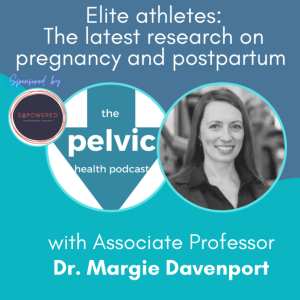
Friday Aug 05, 2022
Friday Aug 05, 2022
Dr Margie Davenport is an Associate Professor at The University of Alberta where her areas of research including investigating the maternal-fetal transmission of chronic disease and exploring the role of exercise in pregnancy as a preventative strategy in the development of chronic disease. Margie and her team are sure shaking up our thoughts on type and intensity of exercise in pregnancy and reframing our mindset from "can exercise in pregnancy be harmful?" to - "Not participating in exercise in pregnancy IS harmful".
Todays’ episode, she joins us to discuss the new exercises guidelines in pregnancy and how they were developed. In addition, Margie shares with us the findings of her new qualitative research on the experiences of pregnancy and motherhood for Elite Female Athletes.
We had a great time talking to Margie and we hope you enjoy the episode.
Thank you to our episode sponsor: Empowered Motherhood Program
You can learn more about Margie and links we discuss:
The Get Active Questionnaire for Pregnancy https://csep.ca/2021/05/27/get-active-questionnaire-for-pregnancy/ - (For fellow nerds, this is how it was developed. https://pubmed.ncbi.nlm.nih.gov/35442812/)
Margie's research (Google scholar link)
Website: www.exerciseandpregnancy.caFacebook: Program for Pregnancy and Postpartum Health Twitter: @ExercisePregInstagram: @exerciseandpregnancyYouTube: Program for Pregnancy and Postpartum Health
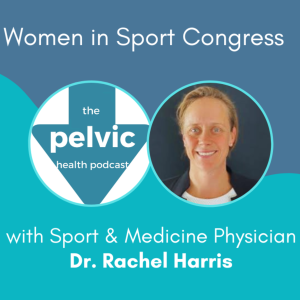
Friday Jul 15, 2022
Friday Jul 15, 2022
Dr Rachel Harris is a Sport & Medicine Physician, Chief Medical Officer for the Australian Paralympic Team for the Tokyo games, and Chief Medical Officer for the Australian Water Polo Team. She is also the Project Lead for the AIS Female athlete performance and health, menstrual cycle and hormonal contraception project. Oh and an Olympian.
Today's episode she joins Jo, Tam and I to discuss the upcoming Women In Sport Congress in Melbourne at the MCG on Aug 17-19, 2022 - a conference not to be missed, with free childcare, sponsored by Brukner & Khan (yep, THE Brukner and Khan from Clinical Sports Medicine. The book that got us all through ;) Rachel shares her background, details about the conference, details about the AIS female pelvic health initiative, and some more cool projects on the way. For those of you who can get to the MCG, be there.
Rachel's Twitter Account
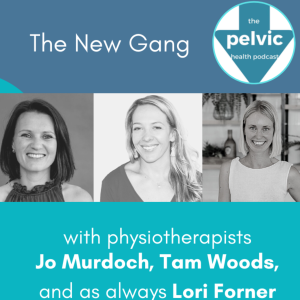
Wednesday Jul 06, 2022
Wednesday Jul 06, 2022
Yes it's still me, Lori, and yes it's still The Pelvic Health Podcast but I have new friends to hang out with and interview with and chat with and we will have so much more fun to come. Listen up, enjoy the fresh voices, and laugh with us while you get to know a little bit more about us all ❤️
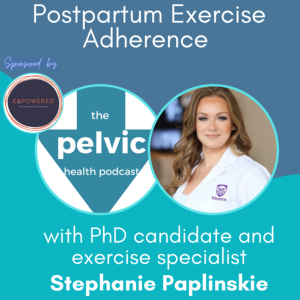
Sunday Jun 05, 2022
Sunday Jun 05, 2022
Steph Paplinskie is a prenatal and postpartum fitness specialist, strength and conditioning coach, PhD candidate in the Exercise and Pregnancy Lab at Western University and international lecturer. Her research investigates the effects of physical activity and exercise training interventions on pregnant and postpartum women. She also runs her own business StrongHer Fitness and is passionate about sharing the science of pregnancy with moms around the world through Precision Pregnancy.
Please fill out (if you are eligible) and share this link for her current study "Postpartum Physical Activity, Pelvic Floor Dysfunction, and Depressive Symptoms (PADDS) Study" https://uwo.eu.qualtrics.com/jfe/form/SV_4GZaX8iDAQKkN81
Enjoy our chat about her research on exercise adherence in postpartum mothers.
And a big thank you to this episode's sponsor (and my favourite resource for pregnant and postnatal/postpartum patients):
The Empowered Motherhood Program
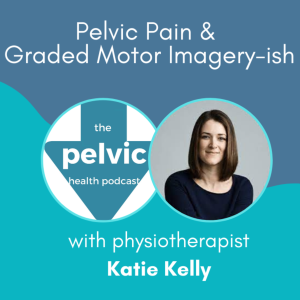
Thursday Mar 10, 2022
Thursday Mar 10, 2022
Today’s episode for is for all you pelvic pain nerds out there. I bring you a brilliant discussion I had with pelvic floor physio, Katie Kelly, on the concepts of graded motor imagery for pelvic pain.
Katie Kelly is a pelvic floor physiotherapist from New Brunswick, Canada. She graduated from the MSc PT program at Dalhousie University in 2010 and has been working with pelvic floor patients for over a decade. She opened her private physiotherapy practice in 2017, and co-opened ReConnect Health Centre, a women’s focused multidisciplinary health clinic in June 2020. Katie is a guest lecturer at Dalhousie University’s School of Physiotherapy where she lectures on the topics of pregnancy and pelvic floor physiotherapy. Katie is an active contributing author to the Canadian Physiotherapy Association’s Women’s Health Division Newsletter. She has a passion for Cesarean section rehabilitation education, recently presented on this topic for the Canadian Physiotherapy Association and teaches a professional course on the subject. Katie has developed a relationship with Mount Allison University’s Sexual Health Lab where she contributes to research involving genital pain conditions. Recently, Katie has launched The Vulvar Image Collection; a resource of vulvar images used in research and education. You can find Katie in the community supporting the role of physiotherapy in pelvic health conditions, or on social media advocating for pelvic floor physiotherapy awareness.
Website: www.katiekellypt.ca, www.reconnecthealth.ca
Facebook: Katie Kelly Physiotherapy
Instagram: @ptkatiekelly
Tiktok: @katiekellypt
Website for The Vulva Image Collection: https://embodiaapp.com/courses/1211-resource-package-the-vulvar-image-collection-katie-kelly-pt
Promo code: pelvichealthpodcast25 Good until August 1, 2022
GMI http://www.gradedmotorimagery.com
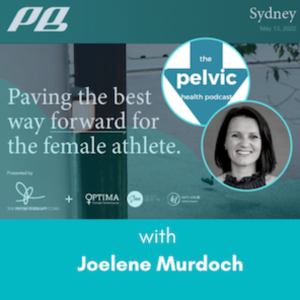
Wednesday Feb 23, 2022
Wednesday Feb 23, 2022
Joelene Murdoch, who is a MSK and women’s health physiotherapist and one of the directors of The Physiotherapy Clinic, joins the podcast to talk about an upcoming conference you are all invited to called Paving the Best way Forward for the Female Athlete taking place in Sydney on May 13, 2022. This conference is for anyone interested in in female athletes, sports physicians, physios, S&C coaches, AEPs, coaches and more. There is the potential for online access at a later date - listen up and stay tuned. Hope to see you there!
Details HERE
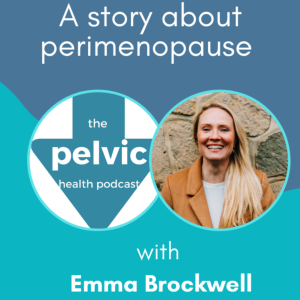
Monday Feb 07, 2022
Monday Feb 07, 2022
Emma Brockwell is a pelvic health physiotherapist, an advocate, an educator, a runner, a podcast host, a mum, and an author. She is brilliant and up to date with evidence around the pelvic floor, yet she still struggled at first to find answers to unexplained symptoms...of perimenopause.
In today's episode, Emma so kindly shares her journey of early onset perimenopause, what she discovered in the research, and what has helped her.
Web: https://www.physiomum.co.uk
Instagram https://www.instagram.com/physiomumuk/
"Why Did No One Tell Me?" Book https://www.physiomum.co.uk/my-book
Runnung Guidelines https://blogs.bmj.com/bjsm/2019/05/20/ready-steadygo-ensuring-postnatal-women-are-run-ready/
At Your Cervix Podcast https://www.physiomum.co.uk/podcast
PelvicRoar
Active Pregnancy Foundation
Preparing for the perimenopause and menopause
Balance app https://www.balanceapp.com
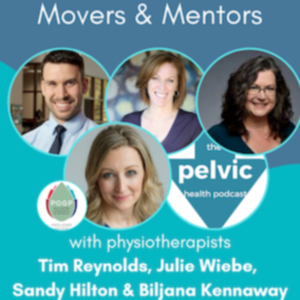
Monday Nov 22, 2021
Monday Nov 22, 2021
Welcome to this international party episode of The Pelvic Health Podcast.
Movers & Mentors is a new book by physiotherapists Tim Reynolds and Bryan Guzski featuring the thoughts and advice from leaders in physiotherapy and movement science - a book in which I was asked to contribute to along with absolutely brilliant names, including both Julie Wiebe and Sandy Hilton.
Tim Reynolds asked to interview me about some of my answers to very cool questions in this book and I thought it would be more fun to have Julie and Sandy join, and decided to make it even more international and exciting by inviting another brilliant physio representing the Pelvic Obstetric & Gynaecological Physiotherapy group - Biljana Kennaway.
I hope you all enjoy!!!!
Find the book HERE
Bios via link on the names above :)
Bios:
Bryan Guzski PT, DPT, OCS, MBA, CSCS (couldn't party with us for this episode) is an outpatient orthopaedic physical therapist practicing in Rochester, NY working primarily with patients with spine related issues and persistent pain. Bryan earned his Doctor of Physical Therapy degree from Ithaca College in 2014, completed an orthopaedic residency program through Cayuga Medical Center in 2015 and received his Orthopaedic Clinical Specialist certification, and earned a Master of Business Administration degree from Simon Business School at the University of Rochester in 2021.
Tim Reynolds PT, DPT, OCS, CSCS is a Clinical Assistant Professor of Anatomy & Physiology at Ithaca College and a part-time physical therapist practicing at Cayuga Medical Center in Ithaca, NY where he predominately treats patients with spine or lower extremity impairments. Tim earned his Doctor of Physical Therapy degree from Ithaca College in 2014 and completed both his orthopaedic residency and spine fellowship through Cayuga Medical Center, and currently helps mentor and teach in both of these programs as well.
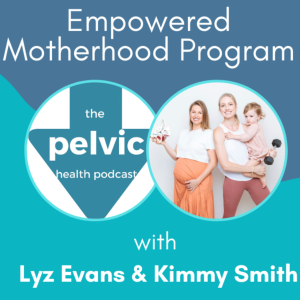
Monday Sep 06, 2021
Monday Sep 06, 2021
I reached out to Lyz Evans and Kimmy Smith to to tell me about the Empowered Motherhood Program because I have watched them work tirelessly to create such a comprehensive and brilliant program and I think everyone needs to know about it. And a side note, this is NOT a paid advertisement. I just believe in this and wish I had their collective brains :).
Lyz Evans is a co-founder of the Empowered Motherhood Program, an APA titled Womens and Pelvic Health Physiotherapist, with over 17 years experience in both the public and private sector. She is the founder of Women in Focus Physiotherapy in Sydney, and spent over 10 years working at the Royal Hospital for Women in Sydney in Maternity, Oncology and Gynaecology.
Lyz completed her Womens Health Masters through Curtin University in 2017, and as apart of her Masters has published clinical research in the International Urogynecology Journal reporting on the multifaceted longer term impacts to a woman of sustaining an Obstetric Anal Sphincter injury.
She is also a busy mum to three young children and has an unwavering passion for armouring women with quality information to enable them to make better choices for their health.
Kimmy Smith is the co-founder of the Empowered Motherhood Program. She is a pregnancy and postnatal exercise specialist, maternal health advocate and a proud Mum to three little girls. Kimmy was a former professional athlete and corporate lawyer. She played at the elite level for over 10 years, representing the NSW Swifts and was a member of the Australia Diamonds Squad. Drawing from her experience as a professional athlete, Kimmy is passionate about supporting women to feel strong during their pregnancy and to return to exercise in a safe and positive way after birth.
Health care professionals listening to The Pelvic Health Podcast can use the link to access:
Two Week Free Trial for Health Care Professionals.
Links to our Find a Physio page where they can list their clinic and reach our members.
EMP Member Pathway
List of Included Content.
Testimonails from Women’s Health Physiotherapists using the program.
https://www.empoweredmother.com.au/the-EMP-for-Health-Professionals
Other links:
WHTA - Women's Health Training Associates
ICS 2021 Melbourne (online)

Friday Aug 06, 2021
Friday Aug 06, 2021
To address long hospital waitlists and improve patient access to care for pelvic floor conditions such as #incontinence and #prolapse , physiotherapy-led pelvic health clinics were introduced as a new model of care for gynaecology, urogynaecology and colorectal patients. Two physiotherapists involved in the evolution of this model of care are Jenny Nucifora and Janelle Greitschus (bios below). In this episode, they explain how this model was developed, the research supporting it's positive impact, and the role and pathway for advance practice physiotherapists in this setting.
Bios:
Jenny Nucifora is the Clinical Lead Physiotherapist in the Physiotherapy Led Pelvic Health Clinic at Gold Coast Health. This part time primary contact role within the urogynaecology team Clinic, was established in December 2016, to provide timely conservative management interventions as part of a strategy to reduce the urogynaecology waiting lists. Jenny continues to work part time in her private practice, Focus On Women Physiotherapy, at Benowa, Gold Coast, Queensland. She has been a Women’s Health physiotherapist for more than 25 years. Her research interests are in improving care of women with urinary incontinence and pelvic organ prolapse, and the development of women’s health physiotherapists.
Janelle Greitschus is a clinical lead physiotherapist in the Pelvic Health Clinic at the QEII Jubilee Hospital, Metro South, Brisbane. This is a part time primary contact role associated with the Gynaecology, Urogynaecology, Urology and Colorectal Departments of this hospital. This clinic was established in 2016 and is designed to reduce the waiting lists of those clinical specialties by providing conservative care for patients with pelvic floor dysfunction prior to them seeing a medical specialist. Conditions included are: urinary or faecal incontinence, urogenital or rectal prolapse, obstructed defaecation or constipation. This provides a streamlined model of care following evidence based practice.
Janelle continues to work at Results Physiotherapy Private practice part-time, treating patients with pelvic floor dysfunction.
Janelle has a sessional teaching role at the Griffith University, Gold Coast and Nathan campuses teaching continence and Womens health physiotherapy in the Undergraduate and Masters of Physiotherapy programmes.
Janelle has been involved in teaching the Assessment and Treatment of the Pelvic Floor Course offered by the APA since the late 1990s until the recent introduction of the Womens, Men’s and Pelvic Health level 1 and 2 courses. She has been part of the successful research grant application “To assess the success and acceptability of a physiotherapy management program to treat urinary incontinence in indigenous women in a community based indigenous health service.”
Research:
Jenny - ResearchGate, email: jennifer.nucifora@health.qld.gov.au
Do patients discharged from the physiotherapy-led pelvic health
clinic re-present to the urogynaecology service? May 2021
Outcomes of a physiotherapy-led pelvic health clinic.
Patient Perceptions of a Group-Based Lifestyle Intervention for Overweight Women with Urinary Incontinence: A Qualitative Descriptive Study

Friday Jun 18, 2021
Friday Jun 18, 2021
Overactive bladder (OAB) is a very common condition involving urinary urgency, with or without incontinence, plus frequency and nocturia. In this episode, urogynaecologist Dr. Kerac Falk joins me to discuss general information on overactive bladder (OAB) with a focus on the medical treatment options - particularly involving recent research he has worked on as part of a team regarding very common anticholinergic medication for OAB and evidence of potential dementia risk.
Dr. Kerac Falk is a urogynecologist (Female Pelvic Medicine and Reconstructive Surgeon), and recently accepted an Assistant Professor of Urogynecology position at the University of Nevada, Reno School of Medicine. He has been involved in researching recurrent UTIs, biofilm, fluid dynamics and our focus for today’s episode was based on his research as part of a founding member of the "Fellows OAB Taskforce for Treatment accessibility” advocacy group.
Dr. Falk will be starting to see patients at his new practice in August 2021. You can find him through his new website (keracfalkmd.com) and a professional Instagram (@keracfalkMD) and Twitter (@KeracFalkMD).
Recent OAB publications include:
Menhaji K, Cardenas-Trowers OO, Chang OH, Hall EF, Ringel NE, Falk K. Anticholinergic Prescribing Pattern Changes of Urogynecology Providers in Response to Evidence of Potential Dementia Risk. Int. Urogynecol.J. Accepted for publication 1/2021, available online 3/2021, pending print.
Escobar C, Falk K, Mehta S, et al. Rethinking Second-Line Therapy for Overactive Bladder to Improve Patient Access to Treatment. Obstet. Gynecol. 2021 Mar;137:1-8.
Johnson TM, Goode PS, Hammontree L, Markland AD, Vaughan CP, Ouslander JG, Falk K, McGwin G, Burgio KL. An Exploratory Analysis of Tamsulosin for Overactive Bladder (OAB) in Men With Varying Voiding Symptom Burden. Urology. 2021 Jan 20:S0090-4295(21)00085-6.
Bennett AT, Ringel NE, Menhaji K, Brown OE, Hall EF, Cardenas-Trowers OO, Falk K, Jeney SES, Barnes H, Escobar C, Tellechea LM, Sappenfield EC, Mehta S, Chang OH. "First, Do No Harm"-Trainees' Observation of Risk Reduction in the Treatment of Overactive Bladder. Female Pelvic Med Reconstr Surg. 2021 Jan 1;27(1):2-4.
Enjoy and thanks again to Always Discreet for sponsoring this episode!

Monday May 24, 2021
Monday May 24, 2021
The International Continence Society Podcast is coming!
On behalf of the ICS Institute of Physiotherapy, I had the pleasure of interviewing Professor Paul Hodges for Episode 1 on Balancing Mobility and Stability within the #pelvicfloor and am excited to be able to share some of it here first. This episode on The Pelvic Health Podcast is only half of our discussion - you can catch the entire episode as of June 1 (2021) on the new ICS Podcast through their website and all major podcast platforms like iTunes and Spotify. The ICS Podcast series line-up is not to be missed and aims to highlight the amazing speakers in pelvic health that will be presenting at this year’s ICS Virtual Conference on October 14-17.
So sit back and get ready to be floored by only some of the wisdom of Prof Paul Hodges on concepts and research on pelvic floor muscle stiffness, movement, pain, strength and so much more. Don't forget to look for the new ICS Podcast in June to listen to the rest of this episode and so much more!
Thank you to Always Discreet for sponsoring this episode of The Pelvic Health Podcast.
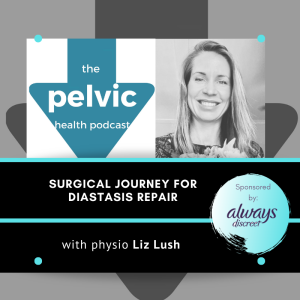
Wednesday Mar 31, 2021
Wednesday Mar 31, 2021
Liz Lush is a Brisbane physiotherapist and clinical lead at Mummy and Co Physiotherapy and Fitness, childbirth educator and tutor for physiotherapy students, and a mother of 4 children. Today she shares her journey (21 days post surgery at the time of recording this) for her large #diastasis or often called #DRA or #DRAM. For previous episodes covering more on DRA research and practical exercise tips, check out the previous episodes (click on the links) with Dr David Larson in July 2020 and physiotherapist Lashonda Jones in Sept 2020
In addition to treating women with DRA for years, Liz not only had a large DRA, she had a ventral hernia, and discusses the different kinds of surgeries and how her journey led her to make the surgical decision. She has such an interesting perspective as both a clinician and a patient.
Follow her visual journey on Instagram at MummyandCoPhysio
Listen and enjoy and a big thanks to Always Discreet for sponsoring this episode of The Pelvic Health Podcast. Head to Always Discreet to learn more about bladder leak tips, management and incredible bladder leakage protection!
Please rate and leave a review on the Apple Podcast app so more people can find it and share on any social media platform, or just with your mates.
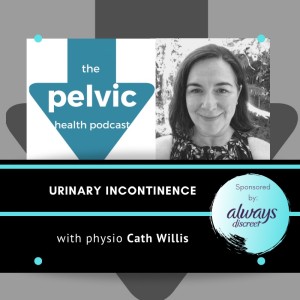
Saturday Feb 20, 2021
Saturday Feb 20, 2021
Today is an extra special episode! We have physiotherapist Cath Willis back (go find the episode on breast health from April 2018) to talk about #bladder leakage, or technically known as urinary incontinence. She breaks down the types and causes for urinary #incontinence, what physiotherapists look for as part of assessment and ways we can help treat this, as well as understanding the importance bladder leak protection products such as Always Discreet.
Not only is Cath a wealth of clinical knowledge in her roles as a pelvic health physiotherapist for Queensland Health and Movements Solutions Physiotherapy in Brisbane, she was our previous Chair of the APA's Women's, Men's and Pelvic Health National Group, is the New Chair of the APA's National Advisory Council, and teaches the undergraduate Gender Health subject to physiotherapy students at Australian Catholic University in Brisbane.
On that note, I want to say a very big thank you to Always Discreet as this entire episode has been made possible by their support.
For more than 30 years across the world, Always has been helping women with their menstruation needs thanks to its comprehensive line of period pads and liners. The brand gained global accolades for some of its previous topical campaigns, including “Like A Girl” and “End Period Poverty.”
As a brand, Always’ purpose has been to empower and help females everywhere live life to their fullest potential. Not only have they created a superior line-up of bladder leak protection products called Always Discreet, they have helped to educate women around the globe about the help from doctors and physiotherapists available for bladder leakage rather than just telling women to use their products and ignore it.
But, what makes the Always Discreet range so great?
It’s specifically designed for incredible protection from bladder leaks (vs. menstruation needs)
It features breakthrough technology via a super-absorbent core that turns liquid into gel and locks in odours
Its products on the range are surprisingly thin and discreet, helping you feel more comfortable and confident going about your everyday life
Now sit back and enjoy!
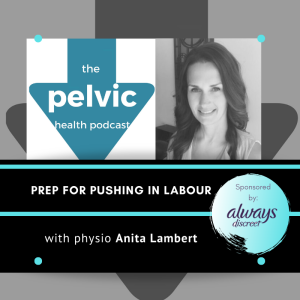
Tuesday Feb 09, 2021
Tuesday Feb 09, 2021
Anita Lambert is a Registered Pelvic Health & Orthopaedic Physiotherapist with a focus on #prenatal, #birth prep and #postpartum care, as well as the co-host of the To Birth & Beyond podcast. She’s one of the few #physiotherapists in Canada to have completed physiodoula training which blends physiotherapy expertise with birth doula support and now assists this professional course taught in Canada.
She joins me today to talk about preparation around stage 2 in labour - what happens in the body, how can we help with breath and #pelvicfloor, where do physiotherapists play a role.
Links for today:
www.holistichealthphysio.com
www.bumptobirthcourse.com
www.tobirthandbeyond.com
IG: @holistichealthphysio
FB: @holistichealthphysio
More of Anita's bio:
Anita is passionate about helping #pregnant physiotherapy clients connect more with their body including their pelvic floor plus keep you active and comfortable during pregnancy while you prepare for birth which will give you a head start on your postpartum recovery. She enjoys helping postpartum clients navigate their recovery and return to activities they love including exercise, sports and dance without pain and pelvic floor symptoms.
Anita created her Bump to Birth online course which guides you step by step to prepare you, your pelvic floor and core for birth and co hosts the To Birth & Beyond podcast to share this information to help people around the world.
Growing up as a ballet dancer and athlete, Anita was always fascinated with how the body moved and healed. Her love for sport led her to become the team therapist for the McMaster University women’s rugby and basketball teams.
She completed her clinicial Pilates rehab training during her final physiotherapy clinical placement in Brisbane, Australia alongside working with semi-professional ballet dancers. She brought this knowledge back to Toronto to start off her physiotherapy career including becoming an on-site physiotherapist for Canada’s Ballet Jorgen and Past President of Healthy Dancer Canada, an organization that fosters and facilitates communication and collaboration among the dance community, health professionals and researchers.
Outside of work, you can find Anita practicing yoga or Pilates, strength training or enjoying the outdoors and spending quality time with her husband and energetic 4 year old daughter and 2 year old son.
Queensland Health Clinical Guidelines for Perineal Care
https://www.safetyandquality.gov.au/sites/default/files/2019-10/severe_perineal_tears_clinical_care_standard_-_consultation_draft_251019.pdf
Upcoming courses/lectures discussed:
Smart Education PowerTalk : "Strength training and the female pelvic floor: what we all need to know
IUGA International Symposium on A Multidisciplinary Approach to the Prevention and Management of Pelvic Floor Dysfunction
Listen and enjoy and a big thanks to Always Discreet for sponsoring this episode of The Pelvic Health Podcast. Head to Always Discreet to learn more about bladder leak tips, management and incredible bladder leakage protection!
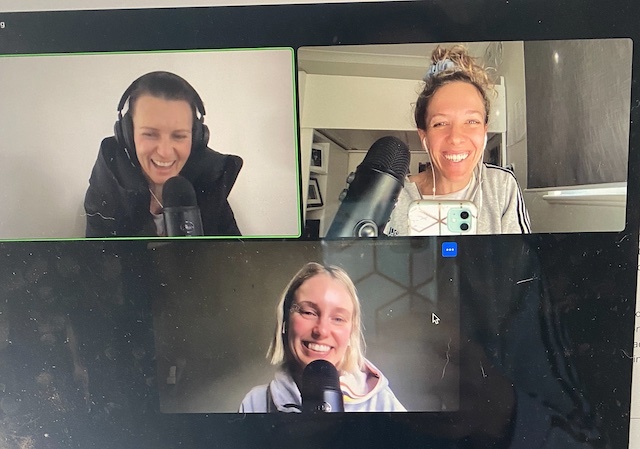
Who are we?
Lori Forner, pelvic floor physio and PhD candidate, is now joined by Jo Murdoch and Tam Woods, who are also pelvic floor physiotherapists.

